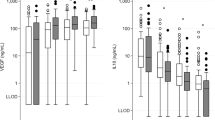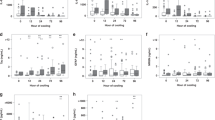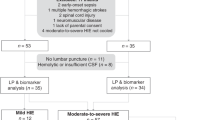Abstract
Objective
To study the serum concentrations of nucleated red blood cells (NRBC) over time in neonates with moderate to severe neonatal encephalopathy (NE).
Study design
A retrospective cohort study with subjects subdivided into three groups: definite sentinel events (n = 52), probable sentinel events (n = 20) and no history of sentinel events (n = 63). Peak absolute NRBC and NRBC/100 WBC were compared between groups and with MRI Injury score, cord and admission pH/base deficit.
Results
Absolute NRBC peaked at 24.05 h after birth (CI: 15.30-32.79), 17.56 h after birth (CI: 7.35-27.77), and 39.81 h after birth (CI: 28.73-50.89) in each respective group. The peak in absolute NRBC correlated with the severity of injury in the grey matter in group 2 and white matter in groups 1 and 2. Higher peak absolute NRBC value correlated to a lower admission ABG pH.
Conclusion
NRBC peak at 24 h after birth in neonates with sentinel events.
This is a preview of subscription content, access via your institution
Access options
Subscribe to this journal
Receive 12 print issues and online access
$259.00 per year
only $21.58 per issue
Buy this article
- Purchase on Springer Link
- Instant access to full article PDF
Prices may be subject to local taxes which are calculated during checkout



Similar content being viewed by others
Data availability
The datasets generated and/or analyzed during the current study are available from the corresponding author on reasonable request.
References
Hermansen MC. Nucleated red blood cells in the fetus and newborn. Arch Dis Child Fetal Neonatal Ed. 2001;84:F211–5.
Sills RH, Hadley RA. The significance of nucleated red blood cells in the peripheral blood of children. Am J Pediatr Hematol Oncol. 1983;5:173–7.
Lippman HS. Morphologic and quantitative study of blood corpuscles in the newborn period. Am J Dis Child. 1924;27:473–515.
Walsh BH, Boylan GB, Murray DM. Nucleated red blood cells and early EEG: predicting Sarnat stage and two year outcome. Early Hum Dev. 2011;87:335–9.
Phelan JP, Ahn MO, Korst LM, Martin GI. Nucleated red blood cells: a marker for fetal asphyxia? Am J Obstet Gynecol. 1995;173:1380–4.
Hanion-Lundberg KM, Kirby RS, Gandhi S, Broekhuizen FF. Nucleated red blood cells in cord blood of singleton term neonates. Am J Obstet Gynecol. 1997;176:1149–54.
Ghosh B, Mittal S, Kumar S, Dadhwal V. Prediction of perinatal asphyxia with nucleated red blood cells in cord blood of newborns. Int J Gynaecol Obstet. 2003;81:267–71.
Hanlon-Lundberg KM, Kirby RS. Nucleated red blood cells as a marker of acidemia in term neonates. Am J Obstet Gynecol. 1999;181:196–201.
Yoon D, Ponka P, Prchal JT. Hypoxia. 5. Hypoxia and hematopoiesis. Am J Physiol Cell Physiol. 2011;300:C1215–22.
Yoon D, Pastore YD, Divoky V, Liu E, Mlodnicka AE, Rainey K, et al. Hypoxia-inducible factor-1 deficiency results in dysregulated erythropoiesis signaling and iron homeostasis in mouse development. J Biol Chem. 2006;281:25703–11.
Huang X, Pierce LJ, Chen GL, Chang KT, Spangrude GJ, Prchal JT. Erythropoietin receptor signaling regulates both erythropoiesis and megakaryopoiesis in vivo. Blood Cells Mol Dis. 2010;44:1–6.
Christensen RD, Lambert DK, Richards DS. Estimating the nucleated red blood cell ‘emergence time’ in neonates. J Perinatol. 2014;34:116–9.
Badawi N, Kurinczuk JJ, Keogh JM, Alessandri LM, O’Sullivan F, Burton PR, et al. Intrapartum risk factors for newborn encephalopathy: the Western Australian case-control study. BMJ. 1998;317:1554–8.
Nelson KB, Bingham P, Edwards EM, Horbar JD, Kenny MJ, Inder T, et al. Antecedents of neonatal encephalopathy in the Vermont Oxford network encephalopathy registry. Pediatrics. 2012;130:878–86.
Kil TH, Han JY, Kim JB, Ko GO, Lee YH, Kim KY. et al. A study on the measurement of the nucleated red blood cell (nRBC) count based on birth weight and its correlation with perinatal prognosis in infants with very low birth weights. Korean J Pediatr. 2011;54:69–78.
Weeke LC, Groenendaal F, Mudigonda K, Blennow M, Lequin MH, Meiners LC, et al. A novel magnetic resonance imaging score predicts neurodevelopmental outcome after perinatal asphyxia and therapeutic hypothermia. J Pediatr. 2018;192:33–40.e2.
Gaulee P, Yang Z, Sura L, Xu H, Rossignol C, Weiss MD, et al. Concentration of serum biomarkers of brain injury in neonates with a low cord pH with or without mild hypoxic-ischemic encephalopathy. Front Neurol. 2022;13:934755.
Merrill HR, Tang X, Bliznyuk N. Spatio-temporal additive regression model selection for urban water demand. Stoch Environ Res Risk Assess. 2019;33:1075–87.
Taylor-Rodriguez D, Womack A, Bliznyuk N. Bayesian Variable Selection on Model Spaces Constrained by Heredity Conditions. J Comput Graph Stat. 2016;25:515–35.
Shah V, Mahmood N, Perlman M. Are Nucleated red blood cells (NRBCs) Markers for timing the hypoxic-ischaemic insult? Pediatr Res. 1998;44:442.
Li J, Kobata K, Kamei Y, Okazaki Y, Nishihara M, Wada H. et al. Nucleated red blood cell counts: an early predictor of brain injury and 2-year outcome in neonates with hypoxic-ischemic encephalopathy in the era of cooling-based treatment. Brain Dev. 2014;36:472–8.
Ferns SJ, Bhat BV, Basu D. Value of nucleated red blood cells in predicting severity and outcome of perinatal asphyxia. Indian J Pathol Microbiol. 2004;47:503–5.
Hebbar S, Misha M, Rai L. Significance of maternal and cord blood nucleated red blood cell count in pregnancies complicated by preeclampsia. J Pregnancy. 2014;2014:496416
Author information
Authors and Affiliations
Contributions
Supervision: MW and JW; Study Design: MW, JW, PG and NB; Data Collection; PG, DR, GG, LS, JH and JW; Writing: PG, NB, DR, GG, LS and MW, Reviewing and editing: all authors.
Corresponding author
Ethics declarations
Competing interests
The authors had no conflicts related to work in this manuscript.
Additional information
Publisher’s note Springer Nature remains neutral with regard to jurisdictional claims in published maps and institutional affiliations.
Rights and permissions
Springer Nature or its licensor (e.g. a society or other partner) holds exclusive rights to this article under a publishing agreement with the author(s) or other rightsholder(s); author self-archiving of the accepted manuscript version of this article is solely governed by the terms of such publishing agreement and applicable law.
About this article
Cite this article
Gaulee, P., Bliznyuk, N., Rajderkar, D. et al. NRBC concentrations over time in neonates with moderate to severe neonatal encephalopathy with and without sentinel events. J Perinatol (2024). https://doi.org/10.1038/s41372-024-01887-6
Received:
Revised:
Accepted:
Published:
DOI: https://doi.org/10.1038/s41372-024-01887-6



